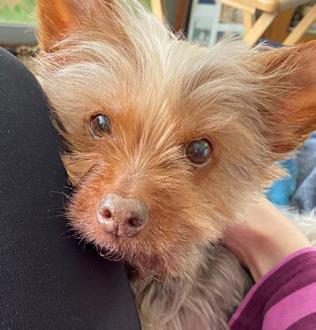
6 minute read
BENEFITS OF PETS
Family Pets are Good for Kiddos
By MARIE WOOD
We love our pets! But did you know growing up with furry and loyal friends bring children joy, love and some cool health and wellness perks?
Since the age of 10, Amanda Senal has had a dog. Now as an occupational therapist at Mankato Clinic Pediatric Services, she sees firsthand how animals benefit children with special needs. In her work to help children gain skills for life, play and school, Amanda sees children who have difficulty with sensory processing and regulating their bodies, heart rate, breathing, movement and balance. When families get an animal, the animal often likes to sleep with the child. “They are getting better quality sleep. They have an easier time falling asleep, staying asleep or going back to sleep. They are not as restless,” Amanda said. At night, the children are benefiting from touch and proprioceptive input with the animal the same as they do during the day. Proprioceptive input is information we gain through our joints and muscles that tell us about our movements and body position. “The animal’s heart and breathing rate can help regulate the child’s heart and breathing rate which in turn improves the body’s natural rhythms,” Amanda explained. Petting or snuggling with a loyal animal helps to calm, soothe and relax us. Bonding with pets has been shown to decrease cortisol, a stress-related hormone and improve the production of oxytocin which is one of our ‘feel good’ hormones! This can lower our blood pressure, improve our breathing rate, and make our whole body feel better overall. Pets can also reduce loneliness and cheer us up. Like adults, many children talk to their pets. While dogs understand many words, they’re even better at understanding how we feel. “When we talk to animals, there is no judgement, no talking back, no telling you how to solve the problem. Children don’t have to worry about – can I tell this truth?” Amanda said. “Dogs give you unconditional positive regard or unconditional love. Animals demonstrate and provide true empathy, one of the most important tools for social skills and emotional well-being.” While cuddling with a stuffed animal is a good substitute, a real animal responds to the child. One child explained to Amanda that dogs are different than stuffed animals. The child said, “A dog would smile at me, wag their tail and give me kisses. The dog would actually move!”
Kyle & Jelly Bean
Kyle Brouwer’s dog, Jelly Bean, helps Kyle with his homework by sitting beside Kyle and keeping him calm while he does his work.
When they’re not doing homework, Kyle and Jelly Bean are playing tug-of-war or Jelly Bean is lounging in his favorite chair. Holidays and ordinary days too, Jelly Bean is often spotted in sunglasses, cowboy hat, a Santa hat or bow tie! At night, Jelly Bean sleeps on Kyle’s bed.
The family adopted this Bichon Frise puppy just before Easter 2020. That’s why Kyle named him Jelly Bean! “He’s such a fluffy bunny,” Kyle said of his Easter dog.
Bichon Frises are known to be helpful for children with anxiety. As a breed, they like to be with their humans. In fact, Jelly Bean gets separation anxiety when the family leaves the house. Jelly Bean looks at their shoes and then it’s to the window where he whimpers and watches as they leave.
“If he’s an anxiety dog, why does he get anxiety?” asked Kyle.
Good question Kyle! When Kyle grows up, he hopes to have a dog and a parrot.

With an amazing capacity to care, Amanda Senal, MA, OTR/L, and her husband adopt rescue dogs with special needs. Currently, the couple has two dogs, Jasper and Gwen. Gwen was a puppy mill mother with anxiety and significant allergies to the outside world, and Jasper has a seizure disorder and severe anxiety.


Kyle Brouwer showed off his dog, Jelly Bean, on the Pets of PTS wall of fame! Alena Nyhammer added her beloved dog Yogi to the Pets of PTS wall of fame! Alena takes her big dog Yogi, a New Foundland and Golden Retriever mix, on walks and plays fetch with him. “He gives me kisses,” Alena said of Yogi. “He looks like a bear!” When Alena had surgery to treat cerebral palsy, Yogi was her mascot and sported a “Team Alena” t-shirt!

Amanda Senal, MA, OTR/L, and Rylee Wagner, MA, CCC-SLP, show off the Pets of Pediatric Therapy Services. The pet wall grew from Rylee’s staff newsletter which featured staff pets. Staff created the bulletin board to invite kiddos to add their own pet profiles and pictures. Children love to stop and see all the animals, especially the puppies.

“I love dogs,” said Rylee Wagner, who has a dog named Ollie which she rescued from a shelter. Rylee, a speech and language pathologist, says Ollie is a quiet guy who doesn’t bark a lot.

Pets can play a key role in child development too. Children learn the life skills and responsibilities of caring and feeding an animal along with social skills of empathy and compassion. “Pets help teach kids responsibility and routine. Kids can help dogs go in and out of the house. They can even learn concepts of measuring by feeding the dog one half cup of food twice a day,” Amanda said. According to the American Academy of Child & Adolescent Psychiatry, pets can even boost a child’s self- esteem and confidence and help children develop trusting relationships with others. And pets teach children about the cycle of life. A family dog can also teach children the important lessons of safety and boundaries. For example, Amanda explained that children learn that dogs have to stay in the yard and can’t run across busy streets. These are rules that children must learn to follow as well.

Above all, a family pet shows children how to treat both animals and people. No hitting or kicking, don’t throw things, and don’t yell or say mean words. Be respectful, patient, and kind! ■
Pets Have Perks for Older Adults
Tesla, our Teddy Bear dog, first crawled into our hearts and home during the pandemic in September of 2020, and quickly became an indispensable member of the family. We never felt alone when Tesla was in the house. He provided us with loving companionship. Every day he waits for me at the door at 5:30 p.m. and melts my heart!
Pets offer many health perks to older adults: • Dogs elicit profound love and nurturance like our own young do. And dogs give us the unconditional love we all need and want from our loved ones.
• Pets can help reduce stress, increase social interaction and physical activity. Pets can also have an astounding effect on symptoms of depression and feelings of loneliness. • Frequent interaction with a pet can lower blood pressure and cholesterol, decreasing the risk of cardiovascular disease.
• Walking, grooming or playing with a pet increases the frequency of physical activity and exercise, which in turn has countless health benefits.
• Being with a pet increases levels of serotonin, the “feel good” hormone that relieves stress. It also provides physical contact, which helps to calm anxiety. • Pets provide companionship, giving an isolated person a source for affection, conversation and activity.
Dr. Bithika Ray with her Teddy Bear dog Tesla Dr. Bithika Ray, her son and Tesla go for walks










